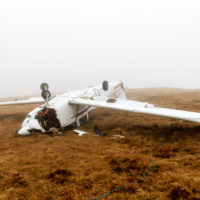Fatal Crash in Lake Hughes Still Under Investigation

A seasoned pilot recently crashed into the side of a mountaintop in Lake Hughes, California, and was fatally injured. The southern California aviation accident was not discovered for several days after the crash, and remains under investigation by the National Transportation Safety Board (NTSB).
The crash occurred on January 12, 2017. The pilot, Fredrick Espiau, was flying a piston-powered, propeller-driven Mooney M20J, purchased by him in 2005. Espiau used the aircraft to commute from Tehachapi to Torrance three days a week. His coworker would frequently pick him up from the Zamperini Field Airport on these days. The morning of the 12th, Espiau’s coworker did not receive a call from Espiau to come get him, but the coworker was not immediately concerned. Several days later, a friend of Espiau’s noticed that his Jeep was parked at the airport, but that no one had seen the man for several days. When he and others determined that the man and his aircraft were missing, they reported that fact to the FAA, which issued an alert notice (ALNOT).
A search crew spotted the wreckage of the aircraft on January 18. The plane had crashed below the Lake Hughes Very High Frequency Omnirange navigation beacon. The craft was extensively damaged, with full-span crush damage to the wings’ leading edges, fracture and crush damage to the forward fuselage, and fracture-separation of the three-blade propeller and its hub from the engine. The investigators managed to find a Garmin GPSMap and portable GPS in the wreckage, and both have been turned over to the NTSB for purposes of uncovering any data contained therein. An analysis of the aircraft’s radar track showed that the plane appeared to climb and descend several times within a span of 15-20 minutes before the crash is believed to have occurred. The plane’s final radar return was received about 1/3 of a mile from the crash site.
Espiau’s Mooney M20J was manufactured in 1978. The plane had been involved in a prior crash with this owner in June of 2016, and the engine had been overhauled in December of 2016. While the NTSB has not yet located the man’s flight logs, Espiau had recently reported to the NTSB that he had logged 2,500 total hours of flight experience and 100 hours of “actual” instrument flight time over the course of his career. Espiau had served as a helicopter pilot in the US Army, and had previously owned a private jet.
According to Espiau’s coworker, he rarely cancelled flights due to weather. The meteorological conditions on the day of the crash were sub-optimal. Weather reports taken at the Tehachapi Municipal airport at 8:30 am on January 12 showed 10 mile visibility, with a layer of broken clouds at 7,500 feet and an overcast layer at 8,000 feet. Twenty minutes later, the overcast layer was at 6,000, rather than 8,000 feet. At a site 20 miles from the crash site, weather reports taken around the time the crash is believed to have occurred showed an overcast layer at 2,400 feet, with a light rain falling.
If you or someone you love has been injured in an aviation accident in California, find out if you may have a claim for money damages after the accident by contacting the knowledgeable and experienced aviation accident lawyers at Magaña, Cathcart & McCarthy for a consultation, at 310-553-6630.


 Close Menu
Close Menu